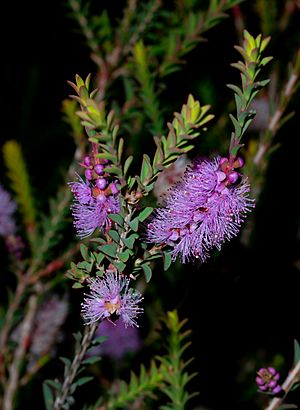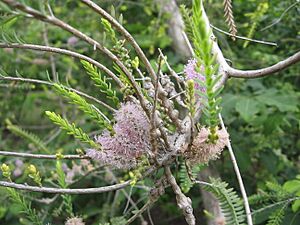Cross-leaf honey-myrtle facts for kids
Quick facts for kids Totem poles |
|
|---|---|
 |
|
| Purple flowers and criss-cross leaves of Melaleuca decussata | |
| Scientific classification | |
| Genus: |
Melaleuca
|
| Species: |
decussata
|
Melaleuca decussata, often called cross-leaf honey-myrtle or totem poles, is a plant in the myrtle family. This plant grows naturally in South Australia and Victoria. Many people in Australia like to grow it in their gardens because its leaves are very attractive. But in some areas of Victoria, it is seen as a plant that can cause problems for the environment.
Contents
What Does the Totem Poles Plant Look Like?
The totem poles plant is a bushy shrub that can grow up to 3 meters (about 10 feet) tall and wide. Its leaves are special because they grow in pairs that cross each other at right angles. This means the leaves are arranged in four neat rows along the stems.
The leaves are small, usually about 4.5 to 15 millimeters (0.2 to 0.6 inches) long. They are narrow and can be shaped like a line or a thin egg, often tapering to a point. If you look closely, you might see tiny oil glands on the underside of the leaves.
Flowers and Fruit
The flowers of the totem poles plant are usually pink or purple. But they quickly change to white as they get older. These flowers grow in spikes at the ends and sides of the branches. Each spike can be up to 16 millimeters (0.6 inches) wide and 20 to 30 millimeters (0.8 to 1.2 inches) long. There are usually 6 to 22 individual flowers in each spike.
The plant flowers for a long time, from August to May. However, most flowers appear from November to February in the places where it grows naturally. After the flowers, the plant produces woody fruits. These fruits are like small, hard seed pods that are often joined together at their bases and seem to be tucked into the stem.
Where Does the Totem Poles Plant Grow?
You can find Melaleuca decussata growing in areas between the coast of South Australia and the central eastern part of Victoria. This includes places like the Eyre Peninsula in South Australia.
Why is it Called an Environmental Weed?
In some parts of Victoria, like the Geelong area and near the Broken and Goulburn rivers, this plant is considered an "environmental weed." This means it can escape from gardens and start growing in natural areas like grasslands and woodlands.
When it spreads, it can form thick patches. These patches can take over and push out other native plants that are supposed to grow there. This can be a problem for the natural environment and for animals that rely on native plants for food and shelter. It often grows well in wet soils that don't have many nutrients.
Growing Totem Poles in Your Garden
Melaleuca decussata is a tough plant that is easy to grow in gardens. It has attractive leaves and pretty purple flowers, even though the flowers fade to white quickly. It can grow in most types of soil and conditions.
However, it's a good idea not to plant this species too close to water pipes, like within 6 meters (about 20 feet). Its roots can be strong and might cause damage to the pipes over time.


